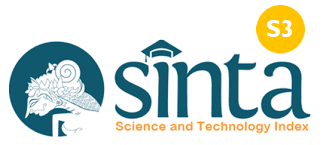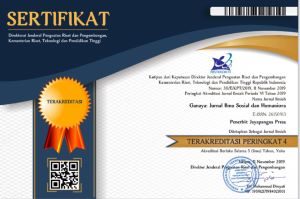An Analysis of Code Switching and Code Mixing on Teacher’s Function of Language Utterances
Keywords:
Teaching English, Code Switching, Code Mixing, SociolinguisticsAbstract
This study discusses code switching and code mixing in the process of teaching English. This study aimed to investigate the teacher's speech containing code switching and code mixing in classroom. This study uses a qualitative descriptive design. Data were analyzed based on Hoffman's theory in finding the type of code switching and mixing code used by the teacher in the classroom, and found the type of language function in the pronunciation of code switching and code mixing and also the teacher's reasons for using code switching and code mixing. Data were taken from classroom observations at the Global Prima School and interviews with teachers to find out the reasons for teachers using code switching and mixing code in the learning process of English. Data were collected in connection with code switching observations and code mixing when teaching English. The results showed that there were 89 code switching consisting of 72 inter-sentential codes or 80.90%. For emblematic code switching there are 11 utterances or 12.36%. For the establishing continuity of the previous speaker there are 6 utterances or 6.47%. On the other hand, there are 107 code mixing consisting of 103 intra-sentential code mixing or 96.26%. For intra-lexical code mixing, there are 4 utterances or 3.74%. In involving a change of pronunciation, the author found that the data was 0%. Most code mixing occurs when teaching English. For the language functions used by the teacher in terms of code switching and code mixing, there are four functions found in this study, they are personal functions, interpersonal functions, directive functions and referential functions, and referential functions is the most used by the teacher in their speech. There are no utterances that contain imaginative functions. There are five reasons why teachers use code switching and mixing code, namely: interjection, the intention of clarifying the speech content for interlocutors, because of real lexical need, expressing group identity and influencing of the first speaker.References
Alti, R. M., dkk. (2022). Media pembelajaran. Padang: PT. Global Eksekutif Teknologi
Auliya, F. A. (2017). Code Switching and Code Mixing in Teaching-Learning Process. English Education: Jurnal Tadris Bahasa Inggris. Vol. 10 (1) 29-45.
Ayemoni, M. O. (2006). Code Switching and Code Mixing: Style of Language Use in Childhood in Yoruba Speech Community. Nordic Journal of African Studies 15 (1), PP. 90-99.
Abbas, F., Aslam, S., & Rana, A. M. K. (2011). Code Mixing as A Communicative Strategy Among the University Level Students in Pakistan. Language in India 11(1), 95-108, January 2011
Aini, Y. S. N. (2017). The Analysis of Code Switching and Code Mixing Used By Maudy Ayunda. Yogyakarta: State Islamic University Sunan Kalijaga.
Asror, M. (2009). Teacher’s Explaining Techniques: Code Switching and Code Mixing in The Classroom. Semarang: Semarang State University.
Creswell, J. W. (2012). Educational Research: Evaluating, Conducting and Evaluating Quantitative and Qualitative Research (4th Ed). Boston: Pearson Education.
Dewi, C & Ekalaya, Y. (2015). An Analysis of Code Switching and Code Mixing in Indonesia Lawyers Club. Literacy Criticism Journal, Vol. 2 No.1
Herman, H., Thao, N. V., Purba, R., & Simanjuntak, N. S. U. (2022). Attracting viewers through advertisement by using code mixing: A sociolinguistics study. Anglophile Journal, 2(2), 80-88. DOI:10.51278/anglophile.v2i2.304
Holmes, J. (2013). An Introduction to Sociolinguistics (4th Ed). New York: Routledge.
Hoffman, C. (1991). An Introduction to Bilingualism. New York; Longman.
Hornberger, N. H. & Mckay, S. L. (2010). Sociolinguistics and Language Education. Bristol: Multilingual Matters.
Kustati, M. (2014). An Analysis of Code Mixing and Code Switching in EFL Teaching of Cross Cultural Communication Context. Al-Ta’lim Journal, Vol. 21, No.3 Page 174-182.
Kothari, C. R. (2004). Research Methodology: Methods & Techniques (2nd Ed). New Delhi: New Age International (P) Ltd., Publishers.
Khairunnisa. (2016). Code Mixing Analysis in English Teaching Learning Process at Senior High School 1 Takalar. Makasar: Allaudin State Islamic Univesity.
Luke, J. C. (2015). The use of Code Mixing Among Pamonanese In Parata Ndaya Closed-Group Facebook. Jurnal Lingua Cultura Vol.9 No. 1
Manik, C. C. M., Hutauruk, B. S., Herman, and Purba, C.N. (2020). Code-Mixing and Code-Switching Found in Photo Captions Instagram of Indonesian Celebrities in 2020. Global Science Journal (GSJ), Volume 8, Issue 9, September 2020, Online: ISSN 2320-9186
Moetia, M. et. al. (2018). Code Mixing and Code Switching in The Classroom Interaction. English Education Journal (EEJ), 9 (2), 229-242
Meyerhoff, M. (2006). Introducing Sociolinguistics. NewYork: Routledge
Muysken, P. (2000). Bilingual Speech. A Typology of Code Mixing. United Kingdom: Cambridge University Press.
Miles, M. B., & Huberman, A. M. (1994). Qualitative data analysis: An expanded sourcebook (2nd ed.). Thousand Oaks, CA: Sage.
Pasaribu, S. R. F., Purba, C. N., and Herman, H. (2021). Code Mixing Realization by Cinta Laura Kiehl on Boy William’s Youtube Channel. Ideas: Jurnal Pendidikan, Sosial, dan Budaya, [S.l.], v. 7, n. 4, p. 25-32, nov. 2021. ISSN 2656-940X. DOI: https://doi.org/10.32884/ideas.v7i4.538
Samosir, L., Herman, Pangaribuan, M., and Sinurat, B. (2020). An Analysis of Code Mixing Used in Net TV Talk Show Program. American Journal of Humanities and Social Sciences Research (AJHSSR), Volume 04 - Issue 10, PP. 21-33
Situmorang, V., Pardede, H., Herman, and Thao, N. V. (2020). An Analysis of Code Mixing Found in Instagram Captions. International Scientific Survey Journal, Vol 3 No 1 (2020), PP. 1-15
Temandoku, G. (2018). Code Switching and Code Mixing. A Teaching and Learning Strategy in St. Teresa’s College of Education. Hohoe: International Journal of applied research: 4 (10), PP. 03-13.
Triana, M., Herman, H., Sinurat, B., & Silalahi, D. E. (2021). An Analysis of Students Perception on the Use of Google Classroom in English Language Learning. Cetta: Jurnal Ilmu Pendidikan, 4(3), 607-618. https://doi.org/10.37329/cetta.v4i3.1474
Van Thao, N., Herman, Napitupulu, E. R., Hien, N. T., and Pardede, H. (2021). Code-Switching in Learning via Zoom Application: A Study in an EFL Context. Asian ESP Journal, Volume 17 Issue 3.1, March 2021.
Wardaugh, R. (2006). An Introduction to Sociolinguistics (5th Ed). Malden: Blackwell.
Yuliana, N., Luziana, R.A., & Sarwendah, P. (2015). Code Mixing and Code Switching of Indonesian Celebrities: A Comparative Study. Jurnal Lingua Cultura Vol. 9, No.1
Downloads
Published
How to Cite
Issue
Section
License

This work is licensed under a Creative Commons Attribution-ShareAlike 4.0 International License.
An author who publishes in the Cetta : Jurnal Ilmu Pendidikan agrees to the following terms:
- Author retains the copyright and grants the journal the right of first publication of the work simultaneously licensed under the Creative Commons Attribution-ShareAlike 4.0 License that allows others to share the work with an acknowledgement of the work's authorship and initial publication in this journal
- Author is able to enter into separate, additional contractual arrangements for the non-exclusive distribution of the journal's published version of the work (e.g., post it to an institutional repository or publish it in a book) with the acknowledgement of its initial publication in this journal.
- Author is permitted and encouraged to post his/her work online (e.g., in institutional repositories or on their website) prior to and during the submission process, as it can lead to productive exchanges, as well as earlier and greater citation of the published work (See The Effect of Open Access).
Read more about the Creative Commons Attribution-ShareAlike 4.0 Licence here: https://creativecommons.org/licenses/by-sa/4.0/.





